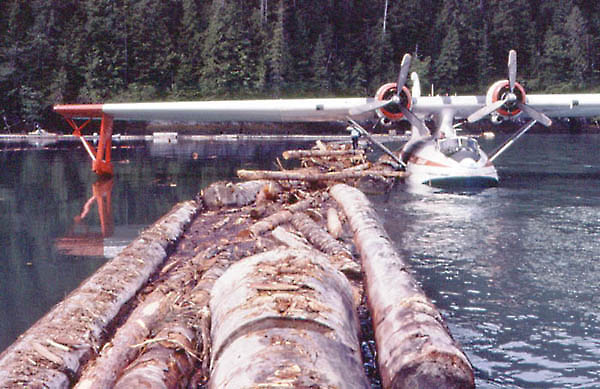|
Poza Rica, Veracruz, 1979
Conair had been contracted by Pemex, the Mexican national oil company, to spray chemical dispersants on oil slicks from the Ixtoc oil well disaster en.wikipedia.org/wiki/Ixtoc_I_oil_spill
We had tanker bases in Merida, Campeche, Ciudad del Carmen, Poza Rica, Veracruz, Tampico, Minatitlán/Coatzacoalcos, Reynosa and Matamoros. I spent most of my time operating out of Poza Rica and Ciudad del Carmen. These photographs were taken while I was working out of Poza Rica.
More photos added over time (2024->), scroll down the page to view them.
|
|
On approach to Minatitlan, Veracruz, during the last week of October 1979.
Yours truly driving Tanker 444, C-GHCA. I remember the crappy weather that week, the peak of the hurricane season that year. I probably should have had my eyes forward at that altitude (duh!).
Note the tank valve / spray control panel on the forward bulkhead.
We had a bird-dog plane to guide us to the day's working area, but then we were on our own.
We used an early commercial version of Omega GPS en.wikipedia.org:_Omega_Navigation_System
and part of my job was to sketch the oil-slick at altitude, take note of sea conditions and winds then program the Omega GPS with a series of parallel waypoints for the spray runs (and do the weight-and-balance math, manage the fuel system, engines, hydraulic systems etc. etc.)
Keep in mind that once you drop down close to sea-level, the view out the window is essentially useless so this was very much an intense instrument operation with three guys in the pointy end of the airplane totally focused on the GPS, the radar altimeter plus all the other usual stuff, constantly cross-checking...
|
|
Poza Rica, Veracruz, August 1979 (taken from the control tower): Douglas DC-6B Tanker 444 C-GHCA & DC-6B Tanker 447 C-GICD.
It was challenging work, hot and dangerous as we had to execute precise spray patterns at 50 feet above the water so functioning dual radar altimeters were part of the go/no-go checklist.
The first few runs were always the most stressful since we were at gross weight with a sea-level temperature typically between 35 and 40 Celsius so performance was a bit of an issue and at 50 feet you are in serious ground-effect.
The other thing to keep in mind is that the DC-6 has a wingspan of about 120 feet/36 meters, so pulling a turn at the end of a spray run at 50 feet may not be a good idea. So the drill at the end of a spray run (after reaching the gps waypoint) was to continue on the existing heading then call 'booms off' (i.e stop spraying), 'climb power', 'flaps 15', 'call 300 feet, '300 feet'....., then make the turn for the next run.
Notes by the Webmaster:
DC-6B C-GHCA (c/n 45197/753) made its last flight Edmonton-Abbotsford on 24sep93; TAT 36.398,9hrs. It was used for parts supply, the tailsection ended up on N861TA of Woods Air Fuel in Alaska.
DC-6B C-GICD (c/n 45496/992) became N151 for Everts Air Fuel in 1996, also in Alaska (see photos on (a.o.) Photos by Friends & Guests PAGE #11 and PAGE #58); note- this was the 2nd DC-6 to become N151 for Everts, the 1st had crashed on 03Mar92. |
|
Poza Rica, Veracruz - September 1979.
Tanker 447 C-GICD (c/n 45496)
The usual end-of-day routine: oil-up and fuel-up. AME Mike Gilderson with the oil-pail, FO Brock Van Doormaal directing the fuel truck.
Depending on the crew mix, we’d all work together to get back to our hotel faster. Some crews let the junior guy (me!) do it all. Not these guys.
|
Poza Rica, Veracruz - August 1979
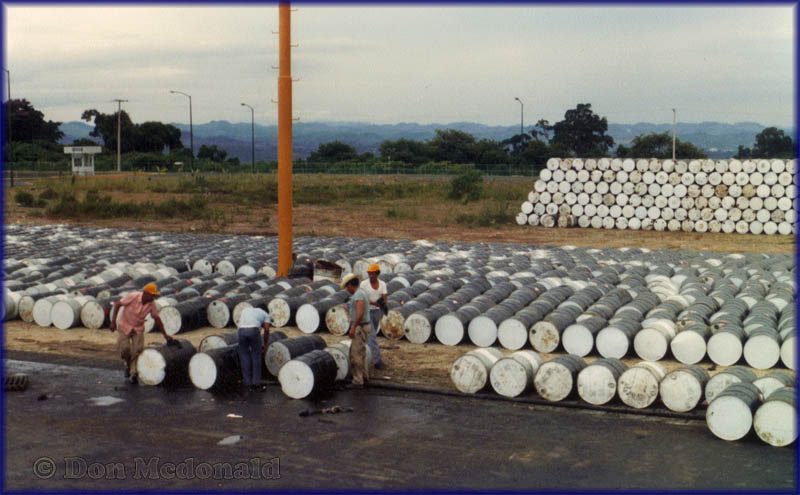
Ciudad del Carmen and Poza Rica were our two biggest bases of operation. This is a shot of the barrels of chemical dispersant we loaded up with. We referred to it as 'goop' and we had our 'gooper' crew as shown in this photo.
The stuff was barged from Houston across the Gulf of Mexico, then trucked to the various bases we operated from.
These guys worked their asses off, unloading and moving barrels, then dumping them into the fill-up trough (the barely visible channel at the edge of the tarmac), then helping me with the pumps and hoses to load the airplane.
Hot, hard and very dirty work...
|
|
I was Second Officer (SO, and occasionally FO) on Tanker 447 C-GICD.
Captain was Alexander Linkewich (who later changed his name to Linc Alexander; Linc also wrote The Book on aerial firefighting, titled Air Attack On Forest Fires / Friesen, 1972). The FO was Brock Van Doormaal.
In October 1979 I moved over to Tanker 444 C-GHCA (DC-6B c/n 45197), following a cryptic note in my logbook on October 10: 'fried #1'...
Tanker 447 was sent back to Canada on a three-engine ferry flight. I’m reasonably certain that Ted Mitchell was captain on this ferry flight, the FO may have been Bjarne Juthans.
Other DC-6 crew I flew with were captains Boyd Cooper, Jim Petrie and Ted Mitchell. FO’s were Bjarne Juthans, Rod Boles and Doug Spence.
In December I was assigned to Tanker 445 C-GHLZ, with Al Linkewich (a.k.a. Linc Alexander) and Bjarne Juthans.
Great guys, all of them.
Best crews I ever worked with and they taught me a lot!
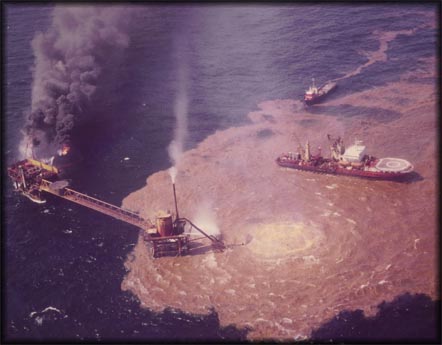
The culprit: Ixtoc I oil spill (Wikipedia)
|
|
Poza Rica, Veracruz - September 8 or 11th, 1979.
Tanker 447 C-GICD
Captain Boyd Cooper and his wife Bonnie are lying on the tarmac, waiting for us to fix the spray booms. Boyd is actually a dentist in Victoria, BC and was filling in due to a shortage of pilots those days!
On the wing, George Mutz (chief mechanic, who is unfortunately no longer with us) and Rod Boles, FO.
Rod is hanging is head because he is:
- physically exhausted
- totally overheated
- wants to go home
- needs a beer
- thinking 'here we go again'
- thinking of something really, really rude!

Refer back to the photo above on which you can see all the barrels of ‘goop’ lined up. They were opened by our Mexican
ground-crew and dumped intro a trough at the edge of the ramp, under the wing of Tanker 444, then pumped from there into the
internal aircraft tanks which was my job to supervise. (SO’s get to do all the cool stuff: loading, oiling, fueling, cleaning the cockpit, emptying ashtrays).
Suffice it to say that we had a problem with dust/dirt/sand/garbage getting into the troughs which would occasionally plug up the spray nozzles. Anyway, George rigged a filtering system for the pumps, using local materials (I think it was as series of burlap sacks).
|
This photo could have been taken at any time from July to October 1979. He was my primary contact with Pemex, as I was the only Conair person who had basic knowledge of Spanish so I did the day-to-day liaison.
If I recall his name correctly, this is Jaime Amesqua Keho, but my spelling of his name may be incorrect.
He was a very competent P. Eng, and a pleasure to work with. He was also quite the student of philosophy and we had many fascinating conversations.
I tried to track him down last year without success.
|
Poza Rica, Veracruz. September 1979.
Juan, the foreman of our 'gooper' crew. A true gentleman, one of those rare individuals you never forget.
|
North of Veracruz, Veracruz. I think this was in September 1979 and we noticed we were being shadowed by the Mexican Navy. A Grumman HU-16 Albatross, I suppose.
|
Reynosa, Tamaulipas - October 10, 1979.
A Douglas DC-4 (note the round windows), leased in from Aero Union;
also note how the titles are incomplete compared to T44 and T47 on the photo top of this page.
Jim Babcock, former Aero Union 'driver', helped identify it:
"It was N67109, our tanker number 17, their number was 449; our two captain's names were Pat Ross and Jerry Sharpe. At Tampico and Vera Cruz. And they only leased one aircraft, though they had an option for another."
(C-54P N67109 c/n 10459 suffered an accident on 30apr90 when the nosegear collapsed on
landing at Chico,CA - fire rupted and the aircraft was damaged beyond economic repair; no fatalities - Webmaster).
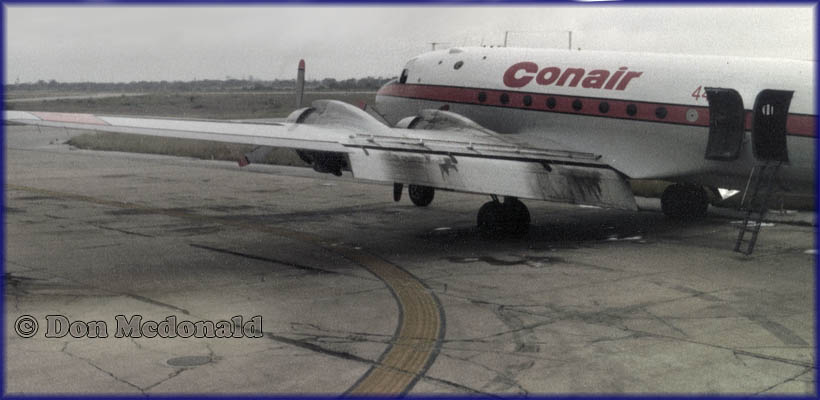
Note the #1 prop in fully feathered position.
Tanker 444 C-GHCA (DC-6B c/n 45197).
"This photo was most likely taken between September 25 and October 10, 1979, Tampico or Vera Cruz.
We ran into the Aero Union guys a couple of times but my best guess is that this picture was taken in Tampico during the first week of October '79. I have a distant memory of talking to their SO (who I thought was a pretty cool and hard-working guy) - it may have been an oil pump failure or just a precautionary shutdown. Anyway, they were flying again the next day.
It was a crazy period according to my logbook: we left Poza Rica September 26th, operated out of Reynosa for 2 days, then moved to Tampico on September 27th and did one trip locally.
On the 28th we did 4 sorties out of Tampico, then returned to Poza Rica where we did another 3 local trips and subsequently tried to get some rest.
On October 2nd, we went back to Tampico for a short visit, then got sent back to Reynosa on October 4th. We stayed there until October 10, which is when I made my cryptic logbook comment 'Fried #1'.
On October 11th, Pemex flew us back to Poza Rica and on October 12th, we transferred to Tanker 444 and went back to Reynosa.
It was a very chaotic time as I recall it.
We had our share of 'technical' too. Sometimes when things go sideways the mechanical stuff doesn’t always work as intended. I remember 'Fried #1' and cranking the rudder trim to just shy of full stop and thinking what if we lose #2?. Shattered a piston on #1, couldn’t get a full feather, the fire extinguishers functioned successfully. All in a day's work."
|
More of Tampico:
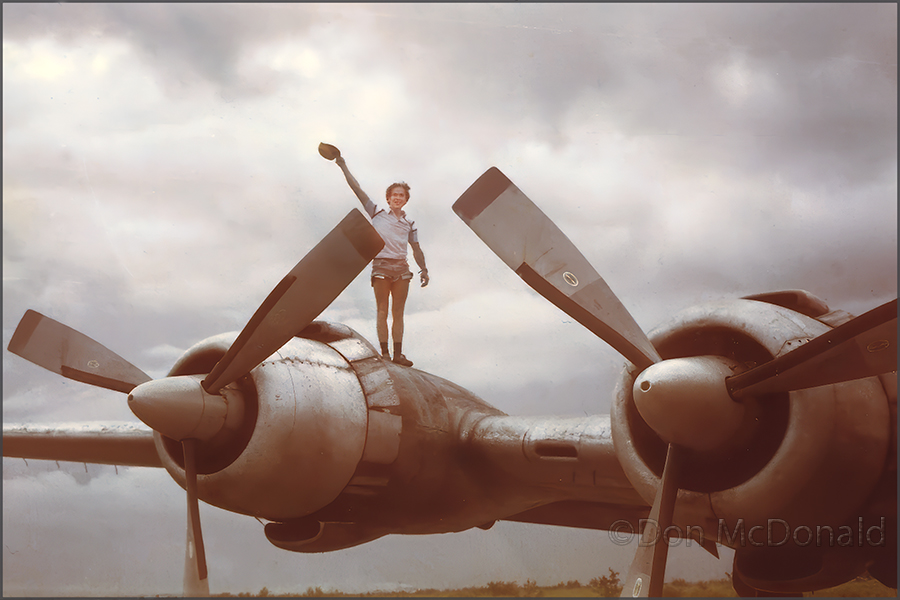
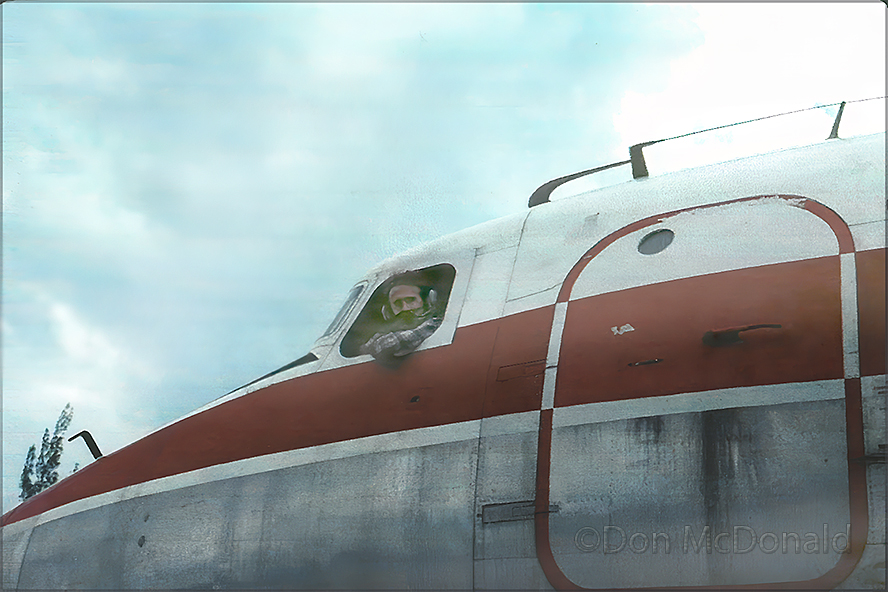
Don McDonald in the left seat of the Conair Tanker 444, DC-6B C-GHCA (c/n 45197), albeit doing engine
run-ups (nine blades!) and hauling oil.
Don: "The socalled 'nine blades' reference is to the 18-cylinder P&W R2800 - you had to count 9 blades during startup to
ensure that none of them were hydraulically locked before hitting the ignition switch (whilst also tapping the 'squirt switch'
after nine blades). Failure to do so could result in "blowing a jug", i.e cylinder failure ergo engine out ergo no flight
today ergo someone is in very deep doo-doo..."
|
 Photos © Don McDonald
Photos © Don McDonald
 Photos © Don McDonald
Photos © Don McDonald
